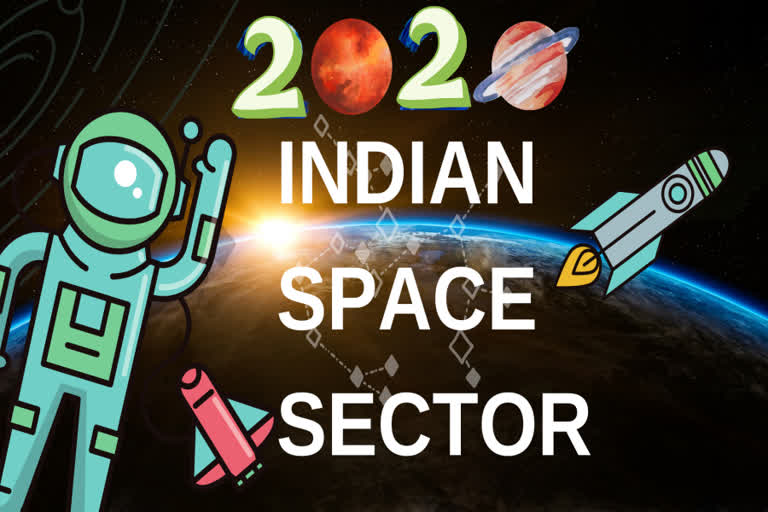Chennai:As a part of that, the Department of Space (DoS) recently signed an agreement with Chennai based small rocket company Agnikul Cosmos Pvt Ltd to access the facilities and technical expertise available in ISRO centres.
- According to DoS, this is the first of its kind agreement to be signed after the establishment of Indian National Space Promotion and Authorisation Centre (IN-SPACe), the authorisation and regulatory body for enabling private players to undertake space activities in India.
- Under the agreement, Agnikul Cosmos will be provided access to the facilities and technical expertise available in ISRO centres to proceed with their launch vehicle/rocket development programme.
A couple of days later, Syzygy Space Technologies Pvt Ltd, commonly known as Pixxel, signed up with NewSpace India Ltd - DoS' commercial arm - to launch its first satellite using ISRO's Polar Satellite Launch Vehicle (PSLV) rocket early 2021.
Pixxel plans to have its Firefly constellation consisting of 30 small earth observation satellites by the end of 2022.
The DoS has also come out with three draft policies - Draft Space-Based Communication Policy of India 2020 (Spacecom Policy-2020), Draft Space Based Remote Sensing Policy and Revised Technology Transfer Policy Guidelines - to enable the private sector play a greater role in the space field.
The DoS Secretary and ISRO Chairman K. Sivan said a policy for launch vehicles and rockets, space exploration and also a comprehensive Space Act will also be announced.
In effect, after the insipid first half, the year 2020 turned a bit interesting after the Central government decided to open up the sector for private players.
During the start of 2020, Sivan had said that ISRO had planned to have 25 launches, including:-
- Aditya-L1 satellite, Geo Imaging Satellite (GISAT-1)
- the realisation of Small Satellite Launch Vehicle (SSLV) or small rocket (carrying capacity 500 kg)
- navigation satellite with indigenous atomic clocks and Indian Data Relay Satellite System (IDRSS)
- GSAT-20 satellite with electric propulsion.
Sivan also said that India will embark on its third moon mission -- 'Chandrayaan-3' -- and attempt to land a lander on the lunar surface sometime in 2020-21.
- The year began well for ISRO with the launch of the 3,357 kg communication satellite GSAT-30 by the European space agency Arianespace rocket Ariane 5 on January 17.
- ISRO also showcased its robot/half-humanoid -- Vyommitra -- which was part of its human space mission programme 'Gaganyaan'.
The first setback of the year for ISRO came on March 4, when it had to call off the launch of GISAT-1, a day before its actual launch, owing to technical reasons.
The ISRO did not share any detail about the technical reasons, or the glitch, and its rectification since then. It is also not known when the satellite with a very good camera would be launched.
Then came the COVID-19 lockdown within and outside India that had its cascading impact on ISRO's core plans like the realisation of SSLV, the launch of GISAT-1, delay in the first test-flight of the rocket as part of Gaganyaan -- India's human space flight mission.
- Meanwhile, two positive developments happened for ISRO -- securing an Indian patent for its liquid cooling and heating garment (LCHG) suitable for space applications and for its method of manufacturing highland lunar soil simulant or simply lunar/moon soil.
- On May 16, Union Finance Minister Nirmala Sitharaman announced that the Indian private sector will be a co-traveller in India's space-sector journey and a level-playing field will be provided for them in satellites, launches, and space-based services.
- She also said that a predictable policy and regulatory environment will be provided to the private players.
The future projects for planetary exploration, outer space travel and others are to be opened up for the private sector, and there will be a liberal geospatial data policy for providing remote-sensing data to tech-entrepreneurs subject to various checks.
On June 24, the Union Cabinet decided to set up IN-SPACe, making ISRO focus on research and development (R&D) of new technologies, exploration missions, and human spaceflight programme.
- The IN-SPACe would provide a level playing field for private companies to use Indian space infrastructure.
- As a part of the rejig, DoS' commercial arm New Space India Limited (NSIL) will endeavour to re-orient space activities from a 'supply-driven' model to 'demand-driven' model, thereby ensuring optimum utilisation of the country's space assets.
